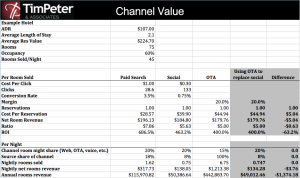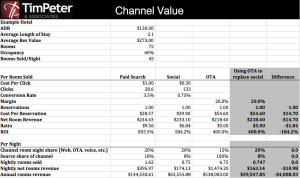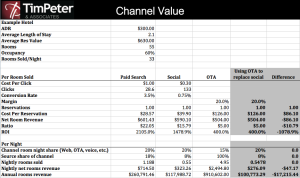Is Social a Waste of Time for Hotel Marketers? (Travel Tuesday)
Want to drive more direct bookings to your hotel? Click here to learn more
Is social media marketing a waste of time for hotel marketers? That’s the conclusion of a report Travolution just covered about a study from booking provider eviivo that offers independent hotels and B&B’s pretty terrible advice. Their claim? Quoting Travolution here, “social media has negligible impact on hotel bookings.” And someone’s done the research, so it must be true, right?
Wrong. Dead wrong in fact.
We do distribution analyses for hotels all the time, using hotels’ actual data and generating an ROI for each channel, increasingly including detailed attribution models. And, from what we’ve learned over the years, I’m not “anti-OTA.” Far from it. In fact, I strongly believe OTA’s play an important role in a fair and balanced distribution strategy. I also have seen, again and again, that OTA’s and other intermediaries increase your costs over time
. That doesn’t mean you shouldn’t use them, only that you need to use them appropriately.
But let’s talk about why social plays an important role for hotels and how it fits into your distribution strategy a bit.
Making Social ROI-Positive for Hotel Marketers
First, you shouldn’t use any channel that isn’t ROI positive. So how can hotel marketers make social ROI positive? Your typical marketing manager at a hotel, using data from the eviivo study, probably spends around 2-3 hours per week on social (the report says that 36% spend more than five hours, which means that most spend fewer than that). Assuming annual salaries of $35,000-$40,000 for your marketing personnel, that means their time costs you between $17.50 and $20 per hour or, roughly $35-$60 per week on social activities. So think about it. How many bookings do you need to make up 60 bucks?
The study also doesn’t state how many of those hours include managing and replying to reviews on TripAdvisor, Yelp, and other social platforms, which remains the single most effective way to improve your brand’s digital marketing performance. I’ll assume “zero” to give them the benefit of the doubt, but I suspect it’s higher than that.
Also don’t forget the sunk cost of labor. Even if your marketing managers spend 5 hours a week on social, they’re clearly doing something with their other 30-35 (or who are we kidding, 50-60) hours per week. So it’s not like the cost of the employee goes away. If you can make social ROI-positive, which you definitely can, it’s often beneficial until/unless you find a better channel to occupy their time.
In my experience, social tends to convert at anywhere between one-half and a couple of percentage points. I’m going to use 0.75% as an “industry average,” but want to note that your mileage may vary based on any number of factors. Still, that means it takes roughly 133 clicks to get 1 reservation. Given $40/week for your marketing manager’s time (and assuming only 1 reservation per week), that means you’re spending—at most—about $0.30 per click (and $40) to drive one reservation from social channels. By contrast, you’re likely paying OTA’s a 20% margin for that same reservation. Depending on your ADR, that’s probably a break-even proposition.
For example, if you’re running a $100 ADR and 2 night average length of stay, one OTA reservation also costs you $40 ($100 ADR x 2 night stay x 20% margin = $40 cost of reservation). Here’s what a simple distribution analysis looks like for a 75-room, upper-midscale independent hotel (I’ve included search to provide a comparison with/alternative to social and OTA):
As your ADR increases, the numbers get even better for social. For instance, here’s an upscale property’s distribution analysis:
And here’s a luxury property (I’ve reduced the room count here to reflect the smaller room counts common among luxury properties):
Obviously, the more rooms you have and/or the higher your ADR, the better these numbers get in favor of social and, for that matter, search. And, yes, if you can negotiate a better margin, that pushes the numbers in the OTA’s favor. And, yes it’s undoubtedly true OTA’s drive volume. That’s a Good Thing™. But other channels usually drive more profitable business.
Of course, an actual distribution analysis should look at each channel within social, search, referral, OTA, and the like independently so you can focus your efforts appropriately. But the point remains, social can often represent a solid channel that’s at least as ROI-positive as any OTA and frequently more so.
Still, not to bury the lead, none of those points represent the biggest problem with the study’s conclusions. So, what does? I’m glad you asked.
You Shouldn’t Put All Your Eggs in One Basket
The study Travolution references almost makes it sound like social’s a waste of time (search, too, for that matter) and that you should give over your sales and marketing efforts to third-parties. This, bluntly, is a terrible idea.
First, what happens when the market turns? Right now, OTA’s face competitive pressures that have reduced their margins, pressures they’re fighting through increased consolidation. However, when demand falls, their huge traffic numbers and vast array of booking alternatives for guests increases their bargaining power and will drive margins up again (a bad thing, from your point of view). It happened in 2001-2002. It happened in 2008-2009. And it will almost certainly happen the next time the economy falters. It just makes good business sense for the intermediaries to do that. Why increase their leverage by relying on them as your primary (or worse, only) source of business? That makes no sense.
Oh, it’s probably worth mentioning that eviivo sells distribution services for B&B’s and hotels to Expedia, Booking.com, and their counterparts. So there’s that.
Even more important, it doesn’t actually work to rely exclusively on OTA’s anyway. Even hotels that depend heavily on OTA’s can’t fill 100% of their occupancy via intermediaries most of the time. There simply isn’t enough demand in most markets to fill all your rooms that way (and if there were, you should expect to see huge increases in developers opening more properties). When demand goes up, guests choose from the available options and seek loads of information to make a good choice. OTA’s commoditize properties and seek to present each property similarly—or will charge you more for featured placements and improved merchandising further inflating your costs. Why not put your effort into answering guest questions on channels where you have more control? And shouldn’t you work to get better at doing that before you’ll need to? That just seems like common sense.
Finally, none of this discussion considers the higher brand value you receive from social and direct websites or the amount of time guests now spend using social sites in their day-to-day lives. But it’s worth remembering that the more places guests can see your property, the more likely it is they’ll think of you when they’re ready to book.
Conclusion
As I’ve said many times, OTA’s aren’t evil. They’re simply one option of many to increase your reach, drive greater consideration, and fill rooms at a reasonable cost—as long as you actually manage those costs effectively.
The same holds true for social. It’s not a magic bullet. But it’s ammunition you can use to increase your reach, drive greater consideration, and fill your rooms at a reasonable cost. As long as you actually manage it effectively too. 😉
Distribution and marketing require thought and analysis. But one thing that remains true is that putting all your eggs in one basket surrenders total control to the folks who own that basket. Make sure you choose a variety of channels that keep you in control of your pricing and inventory and that make it easy for guests to find you where they are.
Social media marketing is not a waste of time for hotel marketers when you do it correctly. Neither are OTA’s. Or search. Or email. Or… well, you get the point. They each play a role to help your guest choose your property when they’re ready to book. When you choose your channels appropriately and manage your resources effectively you’ll find that you rarely waste time. And that your business performs well, too.
If you’re looking to learn even more about how changing guest behavior shapes hospitality marketing, e-commerce, and distribution, be sure an register to receive a special report I’ve produced in conjunction with hotel marketing firm Vizergy, “Digital Hotel Marketing in a Multiscreen World.” While it’s targeted specifically at hotel and resort marketers, the lessons apply to just about any business. You can get your free copy of the report here.
You might also want to take a moment to review the slides from my recent webinar, “Digital Marketing Directions 2016: The Key Trends Driving Your Hotel Marketing Next Year” here:
(And, yes… you can hire me to speak at your next event, too).
Finally, you will definitely want to check out some of our past coverage of the mobile, local, social web and how to make it work for your business, including:
- 10 Key Posts about Millennials and Mobile: E-commerce Link Digest
- The Secrets Behind “It’s All E-commerce” for 2014
- Should Marketers Really Trust Google in 2014?
- The Zen of Digital Marketing Strategy
- 7 Steps to E-Commerce Heaven
- Today and Tomorrow: Mobile and The Changing Customer Journey
- Mobile Makes E-commerce Even More “Frictionless”
- Your 2014 Internet Marketing New Year’s Resolutions – Thinks Out Loud Episode 56
If you’re looking to learn even more about how changing guest behavior shapes hospitality marketing, e-commerce, and distribution, be sure an register to receive a special report I’ve produced in conjunction with hotel marketing firm Vizergy, “Digital Hotel Marketing in a Multiscreen World.” While it’s targeted specifically at hotel and resort marketers, the lessons apply to just about any business. You can get your free copy of the report here.
You might also want to take a moment to review the slides from my recent seminar, “Digital Marketing Directions 2016: The Key Trends Driving Your Hotel Marketing Next Year” here:
(And, yes… you can hire me to speak at your next event, too).
Finally, you will definitely want to check out some of our past coverage of the mobile, local, social web and how to make it work for your hotel, including:
- Is Social a Waste of Time for Hotel Marketers?
- 5 Fantastic Insights Into 2016 Travel Marketing Trends: Hospitality Marketing Link Digest
- 6 Key Hotel E-commerce Tips: A Cheat Sheet to Drive Direct Business
- 5 Hospitality Marketing Trends You’ll Want to Keep in Mind: Hospitality Marketing Link Digest
- Expedia’s Accelerator Program: A Wolf in Wolf’s Clothing
- For Travel Marketers, Content is Still King
- Trends in Hospitality Digital Marketing for 2016
- 8 Great Posts About 2016’s Top Trends: Hospitality Marketing Link Digest
- 5 Key Facts About Mobile, Millennials, and Hotel Marketing
- How Safe Are Independent Hotels from Airbnb?





This Post Has 0 Comments